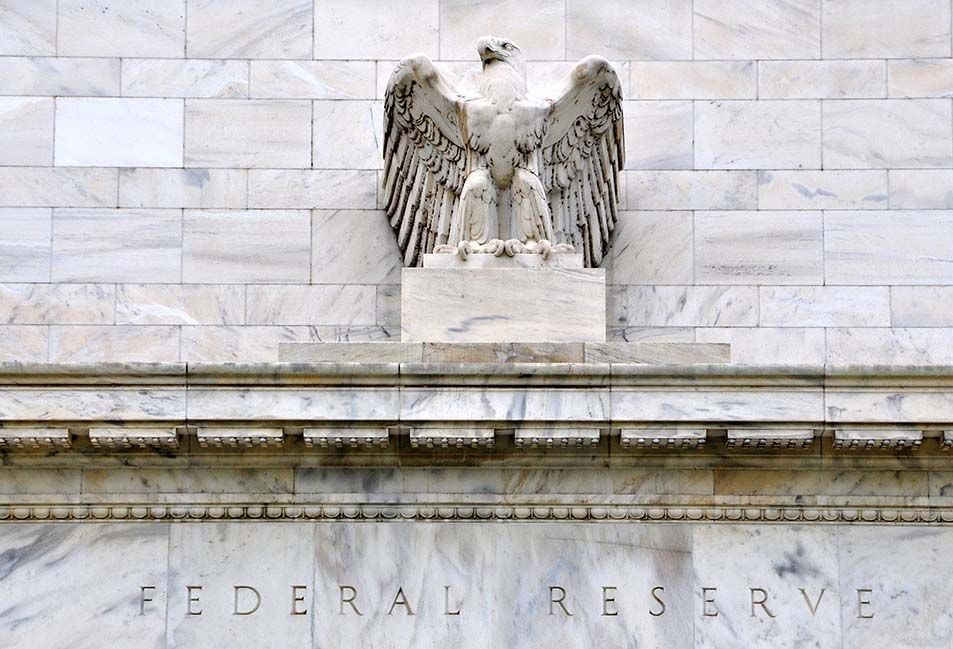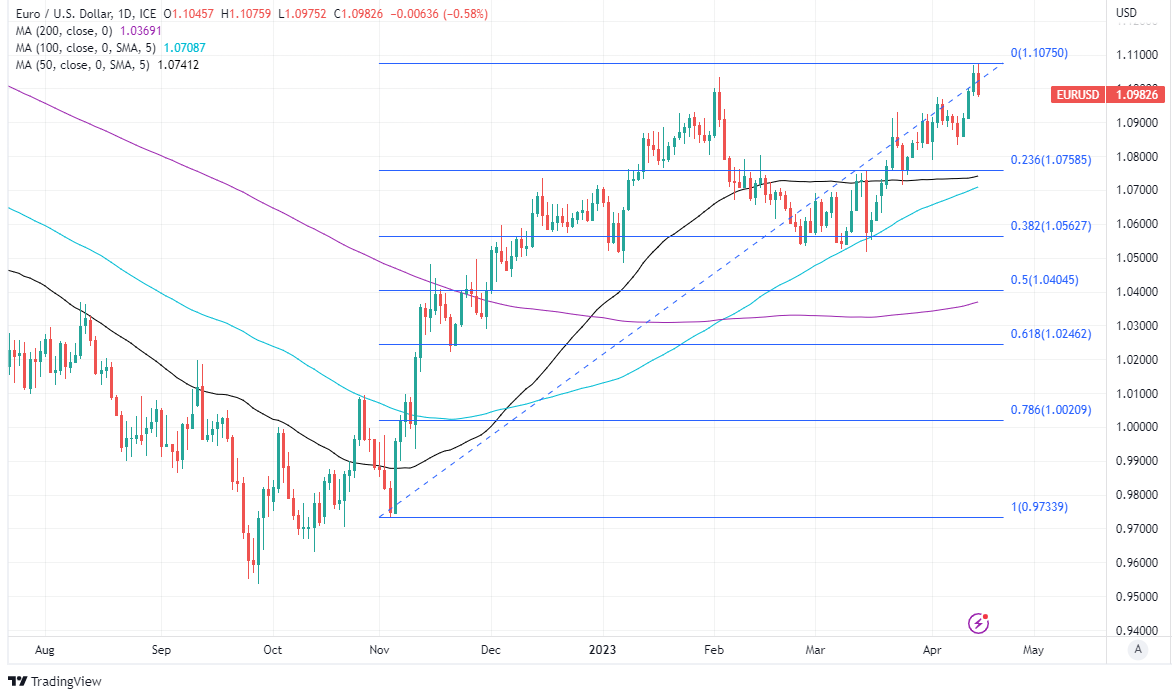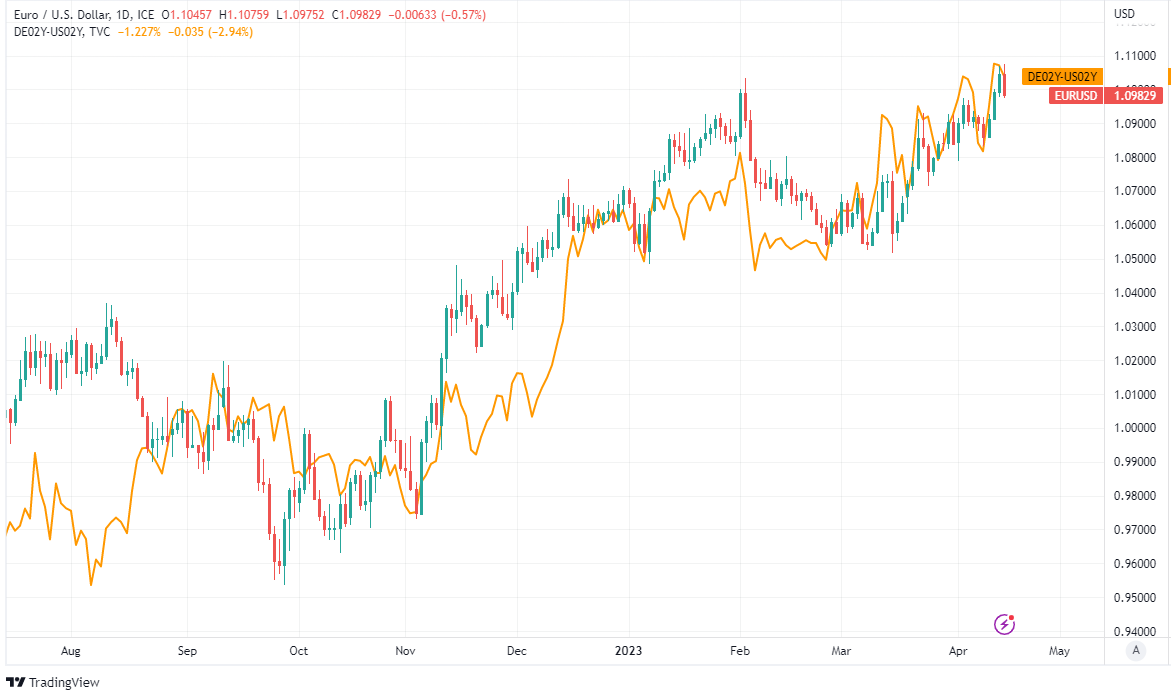EUR/USD Recovery Meets Fresh Federal Reserve Headwind
- Written by: James Skinner
"Whether you measure inflation using the CPI or the Fed's preferred measure of personal consumption expenditures, it is still much too high and so my job is not done," Federal Reserve Governor Christopher Waller.

Image © Pound Sterling Live
The Euro to Dollar exchange rate unwound some of its earlier gains in the final session of the week when falling U.S. retail sales figures were followed by remarks from Governor Christopher Waller suggesting the Federal Reserve (Fed) interest rate could rise further over the coming months.
Europe's single currency was close to the top performer among majors on Friday but gave ground to the greenback as the Euro-Dollar rate gave up the 1.10 handle after Federal Reserve Governor Waller suggested the market may be underpricing the outlook for interest rates.
"I interpret these data as indicating that we haven't made much progress on our inflation goal, which leaves me at about the same place on the economic outlook that I was at the last FOMC meeting, and on the same path for monetary policy," Waller said of inflation figures released on Wednesday.
"Financial conditions have not significantly tightened, the labor market continues to be strong and quite tight, and inflation is far above target, so monetary policy needs to be tightened further," he told the Graybar National Training Conference in Texas.
 Above: Euro to Dollar rate shown at daily intervals with selected moving averages and Fibonacci retracements of November rally indicating possible areas of technical support. Click image for closer inspection.
Above: Euro to Dollar rate shown at daily intervals with selected moving averages and Fibonacci retracements of November rally indicating possible areas of technical support. Click image for closer inspection.
U.S. inflation fell further than was expected by many economists in March as the consumer price index measure declined from 6% to 5% when published in the midweek session, but the more important core inflation rate ticked higher from 5.5% to 5.6%.
The core inflation rate overlooks changes in the cost of energy and food as well as regulated price items like alcohol and tobacco so is often taken to be a better reflection of the domestically generated inflation pressures that Fed policymakers are attempting to manage.
This is why the March increase is potentially a spanner in the works for those who may have hoped the Fed's interest rate cycle was all but over, while the prospect of further increases in the Fed Funds rate is a risk for the Euro in light of market pricing of the outlook for interest rates in the U.S. and Europe.
"Another implication from my outlook and the slow progress lately is that, as of now, monetary policy will need to remain tight for a substantial period of time, and longer than markets anticipate," Governor Waller said on Friday.
"But there are still more than two weeks until the next FOMC meeting, and I stand ready to adjust my stance based on what we learn about the economy, including about lending conditions, he added.
Governor Waller flagged forthcoming data covering the housing sector, personal incomes and other segments of the economy as important influences on his own interest rate decision next month but warned that without signs of "moderating demand," borrowing costs would likely have to rise further.
 Above: Market-implied expectations for G10 central bank interest rates by year-end. Source: Goldman Sachs Marquee. (To optimise the timing of international payments you could consider setting a free FX rate alert here.)
Above: Market-implied expectations for G10 central bank interest rates by year-end. Source: Goldman Sachs Marquee. (To optimise the timing of international payments you could consider setting a free FX rate alert here.)
Federal Open Market Committee members projected on average in February that U.S. interest rates would likely have to rise to somewhere between 5.1% and 5.4% in suggestion of as many as two further increases in the Fed Funds rate still to go for this year.
Meanwhile, Governor Waller himself told the Mid-Size Bank Coalition of America in Los Angeles soon after the February forecast that he would support raising interest rates in that manner if U.S. employment growth remains robust and if inflation does not clearly resume the downward path seen previously.
Since then, employment growth has continued to moderate while some parts of the economy have begun to shed jobs, although it's inflation that matters most to the Federal Reserve and Governor Waller at least is not yet content with the deceleration of prices.
To the extent that other Federal Open Market Committee members are of the same view, financial markets could be compelled over the coming weeks to abandon continuing bets that the Fed is likely to cut its interest rate before year-end and to price-in further increases.
That would act as a headwind for the recovery in the Euro to Dollar rate and if the recent correlation with the two-year interest rate differential is anything to go by, it's one that could potentially lead the single currency to trade closer to the 1.06 level than the 1.10 handle given up on Friday.

Above: Euro to Dollar rate shown at daily intervals with spread or gap between 02-year U.S. and German bond yields. (If you are looking to protect or boost your international payment budget you could consider securing today's rate for use in the future, or set an order for your ideal rate when it is achieved, more information can be found here.)




